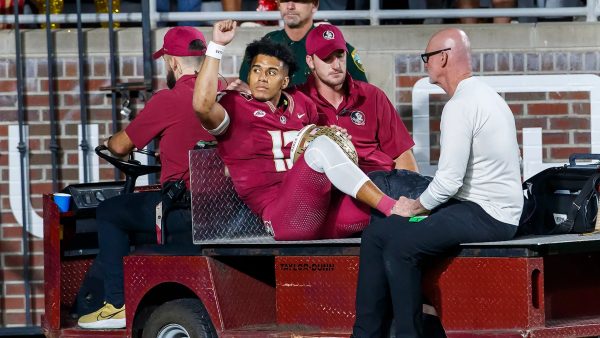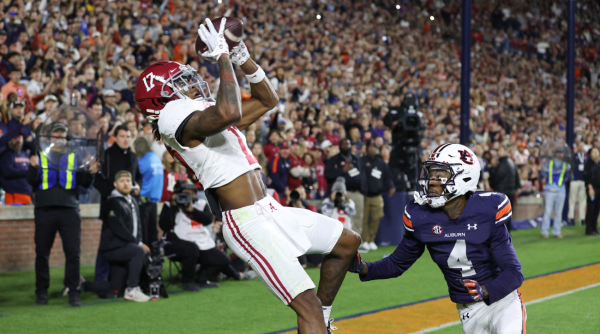
Nine years ago, in 2014, the College Football Playoff (CFP) debuted to the world. The College Football Playoff comprises the top four teams in college football, selected by a thirteen member committee of former players, coaches, and current school executives. The purpose of the playoff was to make a fairer system, letting a higher number of schools display why they were the best team in the nation and thusdeserving of being the National Champion. In the past, at the end of the season, the top two ranked teams played a one-game, winner-take-all, National Championship Game.
Now, in the College Football Playoff, the “top four teams,” selected by the committee at the end of the regular season, play in a tournament style (1 seed vs. 4 seed & 2 seed vs. 3 seed, winner of each play in the championship game) to decide the best team in the country. Over the past nine years, it has worked reasonably well, but flaws have emerged. Four teams do start to seem like a slim number of teams worthy enough to win, especially considering that the NCAA Basketball playoffs consist of 64 teams.
In the current era, the top four ranked teams have won the tournament only 63% of the time. Basketball may be a very different sport, but in sports, it is never a guarantee that the best team will win. With this and many other arguments being directed towards the NCAA, they decided that the College Football Playoff will be expanded to 12 teams in 2024, a decision that has been long awaited by fans and teams respectively. Now, to the current dilemma that has been highly debated in the past few weeks…
On December 3rd, 2023 the College Football Playoff standings were finalized by the committee. This was the last year of the four-team CFP, and unlike most other years, because of the bonkers season and the games that transpired just the day before, no one knew exactly what the committee would decide on.
There were six teams with a legitimate argument to be included in the College Football Playoff:
Michigan was as close to guaranteed a spot as you could get, going undefeated and conference champions in the Big 10 with impressive wins at Penn State(10) and against Ohio State(7). Their offense mostly revolved around their two excellent running backs, Donovan Edwards and Blake Corum. Their defense was also one of the best in the country, ranking top 5 in the nation in both yds/play and yds/game allowed.
Washington, similarly to Michigan, was virtually a lock to be included in the playoff, being undefeated and conference champions in a difficult Pac-12 conference. They had a nation-best five top-25 wins in one of their best seasons of recent memory and were led by their Quarterback Michael Penix Jr. who led the country in passing yards (4218).

Florida State is where things began to get tricky for the committee. Florida State, like Michigan and Washington, was undefeated in the ACC (not as strong as the PAC 12 or BIG10 this year), but a Power 5 conference nonetheless. They won a gritty 16-6 game against 14th-ranked Louisville for the ACC championship the day before. A game that displayed one of the most impressive defensive performances of the season by any team, with 7 sacks, 14 tackles for loss, 10 passes defended, and an interception. With this resume, Florida State is a lock, right? Not totally, since 2 games previously their star Quarterback Jordan Travis broke his leg finishing his season. This understandably hurt their offense a lot, but they still won the games they needed to win.
Texas was also a conference champion (BIG 12), but unlike the other 3 teams suffered a loss in the Red River Rivalry against Oklahoma(12) in October. Even with this loss though, they were seemingly guaranteed a spot due to their week 2 win at Alabama, which was seen by many as the best win of the whole season. This win ended up holding great significance in the race for a top-four spot, for reasons I’ll get to later.
Georgia stood at the top of college football for the last two years winning back-to-back National Titles. Similar success came this season being ranked #1 in the AP poll 11 out of 13 weeks. In the SEC Championship, the day prior, they lost 27-24 to Alabama. Their first loss couldn’t have come at a worse time though considering the implications. Based on their record, they weren’t going to pass up Michigan, Washington, and Florida State. They couldn’t pass Alabama due to their head-to-head loss, and couldn’t pass Texas due to them beating Alabama, who Georgia lost to. Seemingly the only way Georgia would make it into the playoff is if the committee strictly based their rankings on the so-called “eye test”, a term widely used in the leadup to the rankings. Yes, getting removed from the top four after losing one game this season by only 3 points does seem like a harsh punishment, but considering the circumstances there was no other way.

Finally, we come to Alabama: A year unlike past for the Crimson Tide was bound to bring many controversies throughout the season. They looked quite shaky at the beginning of the season after losing their second game to the previously mentioned Texas Longhorns. The week after they had another lousy performance, only beating a (6-6) USF team 17-3, a team they should have trounced. These subpar performances could be attributed to the mediocre quarterback play between Freshman Ty Simpson and Sophomore Jaden Milroe. They were both competing for a starting spot, and Milroe out of the two showed greater promise which led Nick Saban to designate him the starting role. After this, the Roll Tide showed more dominance in their following games showing glimpses of the Alabama we have seen in the Saban era.
Near the end, they came upon their in-state rivals Auburn, who to that point had an unmemorable season with a measly 6-5 record. The game, though, did not disappoint with Auburn being up 24-20 in the final 32 seconds of the game. Alabama was on a 4th and goal, 31 yards from the endzone and they needed a miracle to win. With only a 0.1% chance of winning, Jalen Milroe heaved a ball up to the back left corner of the endzone to Isaiah Bond, winning the game. With that win they booked a ticket to the SEC Championship Game against #1 ranked Georgia who hadn’t lost a single game in their last 29. They narrowly squeezed out another 27-24 win, but this time against a more impressive team.
The case for Alabama making the Playoff was simply based on what they showed in the SEC Championship game beating who many thought were the best team in the nation. They couldn’t be above Texas though because they lost earlier in the season to them, and all that stood in front of them were the 3 undefeated Power 5 conference champions, one of which had an injured quarterback.
So, seeds were released in an over-dramatized fashion. The first seed was Michigan, a decision many saw coming, although others thought Washington deserved the #1 spot. Following them was the before-mentioned Washington Huskies. Third came Texas, and now everybody was wondering if they were going to keep Florida State out of the playoff, considering the circumstances. They then leapfrogged to the sixth spot to confirm that Georgia missed out on the chance to go to the CFP. Now, with Florida State and Alabama fans tense, the fourth spot was up for grabs. Either one of the two firsts would happen: An undefeated Power 5 conference champion would miss out on the CFP, or an SEC team would be left out. Ultimately, Alabama was chosen as the 4th seed in the playoff, leaving Florida State out of the playoff as the 5th seed.

After this controversial decision, there were many split opinions among the ESPN staff covering the selections. Specifically, you have the notorious Paul Finebaum, who is the living, breathing embodiment of the SEC. Hailing from Memphis and a graduate of the University of Tennessee, he was born and raised in the South. For decades he has been the face of the SEC for ESPN. As soon as the Alabama-Georgia game ended, he was stuck on one thing: Alabama should be in the playoff, without a shadow of a doubt. They’re SEC champions, right? After the rankings, he stated, “This is the only way you could’ve done it”.
Keep in mind Alabama was ranked last out of all the Power 5 one-loss teams going into the Georgia game, partially due to them barely squeaking out a win against Auburn just a week before. But the argument that secured Alabama a spot in the playoff is that they beat the number one team in the nation, who were previously back-to-back national champions. What you’ll notice is that the majority of the time these talking heads always mention back-to-back national champions when describing Georgia. However, Georgia is not the same team they were in previous years, given they lost 22 players from last season’s team alone. Funnily though the reason Florida State did not get in is because they “weren’t the same team” without Jordan Travis, their starting Quarterback. But, who Georgia lost from their back-to-back title wins going into this season, was their quarterback Stetson Bennett, yet they are still revered as the immense powerhouse they were with him.
One of my biggest problems with the final rankings was the committee’s lack of consistency. With Florida State out of the top four, it showed that the committee valued the “eye test” over actual results. They complained that Florida State’s third-string quarterback threw only 55 passing yards, even though they beat an underrated Louisville team despite a poor performance on offense. Alabama and Georgia, on the other hand, both had more than 300 total yards of offense in their clash, which seemed to be more easy on the eye for the committee members.
Georgia, according to the “eye test,” should’ve also been above Florida State in the rankings due to their more impressive performance on the offensive side of the ball. But since their loss was more fresh in everyone’s minds they were ranked last out of the six. The committee did it halfway, which I think is a reason many are upset. They could’ve based the whole thing on how good their team looked at different points in the season, or they could have strictly looked at the resume to decide the teams. They said, “Let’s meet in the middle ”, which, in this case, just meant frustrating inconsistency.
The main reason for this selection boils down to the one thing people care about most: money. The two highest-earning conferences in revenue are the Big10 and SEC. Both of them each make about 200 million dollars more than the next conference (ACC). Much of this can be attributed to the monster television deals with the SEC, earning 55 million per year with a CBS sponsorship, that they’re leaving in 2024 to sign a 300 million dollars per year contract with ESPN. The Big10, though, signed a contract this year with CBS, NBC, and FOX worth an average of 1 billion dollars per year. They make a lot of money. On top of that, each conference makes 6 million for each team they put into the college football playoff. Not as gargantuan a number as their TV deals, but a decent sum nonetheless.
The real controversy, however, comes with the CFP’s revenue. Right now, with the four-team playoff, the CFP makes roughly 470 million dollars, most of which comes from viewership. The College Football Playoff is arguably ESPN’s most lucrative program, so the number of viewers matters a great deal. What viewers want to see is the “best” matchups, with high-powered offenses that produce lots of highlights. Could the Playoffs have been chosen on which matchups produce the most views, to create the most money?

Your average fan does not want to watch Florida State scrape away wins with stellar defensive performances. They would rather see a 4th and 31 be converted with a game-winning touchdown with 32 seconds left, no matter the quality they showed before that play. But at least we aren’t going to get another TCU-Georgia matchup which averaged the least amount of views on average of any championship game since the playoff began.



















